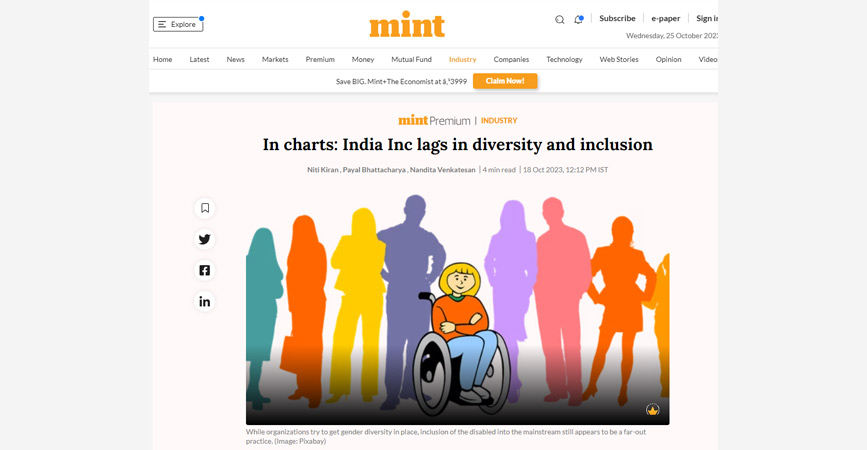
India’s largest publicly-traded companies employ three men for every woman in their workforce, indicating a wide, persistent gap despite growing corporate clamour about diversity. The 94 companies on the BSE 100 index that have reported this data had an aggregate 25.9% women on their staff as of 31 March 2023, a Mint analysis of their latest annual reports showed.
A clear trend over time isn’t clear as many companies had not reported comparable data earlier. That’s because 2022-23 was the first year when stronger sustainability- and diversity-related disclosures became mandatory for India’s top 1,000 listed firms. Still, around half of these companies reported the data in each of the last three financial years, among which the share inched up from 24.6% in 2021 to 27.9% in 2023. The analysis relies on the numbers of permanent and non-permanent staff, and excludes workers.
Leaders and laggards
Women have stayed on the margins of the formal workforce, bogged down by demands and stereotypes of the traditional patriarchal society. Even as norms evolve, rules made to bring and keep women in the workforce are sometimes having unintended consequences. For example, legal obligations such as paid maternity leave of six months might deter a section of employers from hiring women, said Lakshmi Ramachandran, partner, labour laws, JSA Advocates and Solicitors. Such reasons can affect smaller companies even more.
Women have relatively better representation—though still far from parity—in information technology (IT) (35%) and financial services (23%), the analysis showed. Metals and mining, chemicals, power, and auto trailed with less than 10% share.
“While sectors such as banking, technology and FMCG have a good mix of women leaders, sectors such as engineering, automotive, aerospace and defence have relatively lower representation,” said Kunal Girap, co-founder and director of WalkWater Talent Advisors. For instance, large engineering companies having projects across the country may have less women talent as the need would be to stay for longer periods in remote areas, he said.
Anurag Mehrotra, chief human resources officer at APL Apollo Tubes, a leading producer of structural steel tubes, said the underrepresentation in his sector echoed across the metal and mining arena. “The problem lies in these industries having historically failed to be welcoming or actively encouraging female participation,” he said. “But there is a positive shift ongoing.” (The metals and mining space has increased women’s share from 8.3% to 9.6% in the last three years, the analysis showed.)
Meanwhile, 20 of the 45 companies that reported the numbers in all three years have managed steady gains during this period. These include companies in the pharma space, chemicals and automotives.
Yawning gap
Diversity is not just a buzzword. Making a stronger business case for it, a McKinsey report in 2020 found that more diverse companies were more likely than ever before to outperform peers on profitability. Studies before the pandemic also showed the drastic extent to which India could expand its GDP with a gender-equal workforce.
Lohit Bhatia, president, Indian Staffing Federation, suggests a crucial role of state governments in supporting small businesses to hire women, or taking steps such as women-centric mobility options for safe travel during late shifts, or adequate street policing at night. For employers, readiness matters. “We have good laws in place that need to be enforced better, and the spirit behind these laws needs to be explained to employers,” Ramachandran said. “Create inclusive policies not just to tick off a checkbox but actually to walk the talk.
“Meanwhile, programmes to rehire women who have taken a career break can help. SBI Cards and Payments Services, which began a similar programme, had 51.9% women in March 2023, the highest in the analysis. A lot also depends on how prominently diversity features in the agenda of the top leadership. Embracing the concept of mandating women’s representation at the employee level (there are rules already at the board level) is an exciting notion for leaders, but it’s crucial to recognize that distinct industries need distinct approaches, Mehrotra said.
While organizations try to get gender diversity in place, inclusion of the disabled into the mainstream still appears to be a far-out practice. For every 1,000 employees, only four persons with disabilities are on the rolls of the 94 companies in the analysis. This is despite a law mandating 3% reservation for disabled persons both in direct recruitment and in promotions in public sector jobs.
Persons with disability are mainly hired at junior levels and their presence drops at upper levels, noted a Randstad report released in March. Although the pandemic was an enabler, blue-collar jobs, especially at the factory level or outdoors, are seen as less available for them, needing more investment by employers prior to hiring, the report said.
Here, too, as in the case of gender parity, the top leadership’s involvement remains critical in driving inclusion, and it rests on better enforcement of the existing laws.
Source: Mint








